NASA is investigating this 'mystery' data coming from Voyager 1


NASA scientists are trying to make sense of buggy system data the interstellar Voyager spacecraft is transmitting from about 20 light-hours away from Earth, some 45 years after it launched.
Voyager 1 launched in September 1977 and is now the farthest spacecraft from Earth, traveling in space at about 14.5 billion miles (23.3 billion kilometers) away. It would take light about 20 hours to travel from the spacecraft.
Space
NASA's Jet Propulsion Laboratory is investigating a glitch in the system data the interstellar explorer is collecting. Readouts from the probe's attitude articulation and control system (AACS) "don't reflect what's actually happening onboard", according to JPL.
SEE: NASA's Mars lander is running out of power. Here's what happens next
Everything about the AACS suggests it is functioning normally, yet the telemetry data it's sending back to Earth is "invalid", producing what appears to be randomly generated data that doesn't match any possible state the system could be in.
The AACS controls the Voyager 1's orientation and keeps its high-gain antenna trained on Earth for optimal data transmission.
The spacecraft would be put into a functionally reduced 'safe mode' if Its onboard fault-protection systems had been triggered. Its signal remains strong but the data appears to be malformed, according to NASA JPL.
NASA considers anomalies like this to be normal for a spacecraft of its age.
"A mystery like this is sort of par for the course at this stage of the Voyager mission," Suzanne Dodd, project manager for Voyager 1 and 2 at NASA's Jet Propulsion Laboratory in Southern California, said in a statement.
"The spacecraft are both almost 45 years old, which is far beyond what the mission planners anticipated. We're also in interstellar space – a high-radiation environment that no spacecraft have flown in before. So there are some big challenges for the engineering team. But I think if there's a way to solve this issue with the AACS, our team will find it."
Dodd said the team could just "adapt" to the glitch if they can't identify the source of it. If the source is found, it could be fixed by a software update or via one of the spacecraft's redundant hardware systems.
SEE: NASA's Mars helicopter just took these remarkable photos of the rover's landing gear
Voyager 1 was launched from Cape Canaveral after the Voyager 2 took off, but because of its faster route, it overtook its twin to fly by Jupiter in 1979 and then Saturn in 1980, according to NASA. It's also gone further than Voyager 2, which is currently traveling about 12.1 billion miles from Earth.
The Voyager 1 was the first human-made object to reach into interstellar space and in 1998 overtook NASA's Pioneer 10 to become the most distant human-made object. It reached interstellar space in August 2012 and, among other things, takes measurements of the density of material in interstellar space. It will eventually exit the solar system but not for a long, long time.
"If we define our solar system as the Sun and everything that primarily orbits the Sun, Voyager 1 will remain within the confines of the solar system until it emerges from the Oort cloud in another 14,000 to 28,000 years," NASA notes.
Both Voyagers carry a message on a gold-plated copper disc in case extraterrestrials find the spacecraft one day. It also includes a player and instructions describing how to play the content. The disc includes greetings in 55 languages and 90 minutes of mostly Western music.